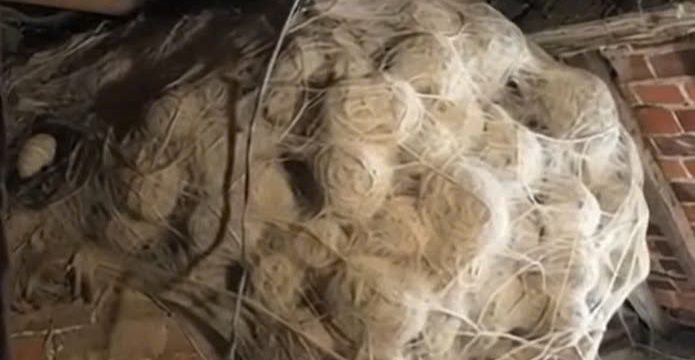There was a time when nearly every home, farm, and roadside stop had one of these. It wasn’t just a common sight—it was a necessity. Before modern plumbing became widespread, this wooden structure stood proudly behind homes, offering what was then considered a luxury. Simple, practical, and essential, it played a crucial role in daily life. Yet today, it has almost completely disappeared.

So, what exactly are we talking about? If you guessed the outhouse, you’re absolutely right. Let’s take a journey through the history of the outhouse, explore why it was once an everyday staple, and uncover what ultimately led to its disappearance from modern society.
🏡 The Outhouse: A Household Essential
Before indoor plumbing transformed sanitation, the outhouse was the primary bathroom solution for millions of people. These small wooden structures were a common sight in backyards, near farmhouses, at schools, and even in public spaces, providing a simple yet effective way to manage human waste.
✔ Typically constructed from wood, outhouses were enclosed structures featuring a bench seat with a hole that led to a pit below. ✔ Some were single-seaters, while larger families or public locations might have multiple holes to accommodate more users. ✔ Many featured a crescent moon cutout on the door, a design believed to improve ventilation and, in some cases, distinguish women’s outhouses from men’s.
For decades, the outhouse was an essential part of daily life, particularly in rural communities and small towns. But what was it really like to live with an outhouse, and why did it eventually disappear?
🚜 Life Before Indoor Plumbing: The Reality of Outhouse Living
Using an outhouse wasn’t exactly glamorous, but it was certainly an improvement over going in the woods. However, it had its fair share of challenges.
🌧️ Rain or Shine, You Had to Go – Regardless of the weather—rain, snow, or extreme heat—if nature called, you had to make your way to the outhouse. 🌙 A Midnight Journey – If you needed to use the restroom at night, you had to grab a lantern or flashlight and carefully navigate the dark outdoors. 🦟 Dealing With Nature – Outhouses were infamous for attracting flies, spiders, and even the occasional snake, turning each trip into an adventure. 📜 No Toilet Paper? No Problem – Before toilet paper became common, people used alternatives like corn husks, old newspapers, or catalog pages as makeshift wipes.
For many families, outhouses were both a necessity and a source of humor. Tales of pranks, unexpected animal encounters, and the dreaded “falling in” accidents were passed down through generations. Yet despite the inconveniences, outhouses remained the best available option for sanitation—until modern plumbing changed everything.
🚰 The Rise of Indoor Plumbing: The End of the Outhouse Era
By the early 20th century, advancements in plumbing technology made indoor bathrooms more accessible and practical.
🏠 In Cities – Running water and sewage systems allowed homes to have flush toilets instead of outdoor latrines. 🚜 In Rural Areas – Many farms and small towns held onto outhouses for years, but as electricity and plumbing became more widespread, even these communities began installing indoor restrooms. 🏡 By the 1950s – The majority of American homes had switched to indoor plumbing, and outhouses quickly became obsolete.
Some outhouses remained as backup options in case of plumbing failures, while others were repurposed for storage or simply abandoned to decay in forgotten corners of old properties.
💡 Why Do Some Outhouses Still Exist?
Believe it or not, some outhouses are still in use today!
🏕️ Campgrounds and Remote Cabins – Many off-grid locations still rely on outhouses, especially in wilderness areas where plumbing isn’t available. ⛰️ National Parks and Hiking Trails – Some parks maintain modern versions of outhouses, known as pit toilets or composting toilets, for eco-friendly waste management. 🏡 Historic Homes and Museums – Some historic sites preserve outhouses as a glimpse into life before modern amenities. 🎭 Rustic Aesthetic – In some rural areas, outhouses are kept as decorative elements or nostalgic tributes to the past.
While most people wouldn’t trade their modern bathrooms for an outhouse, there’s still something charming about these forgotten structures.
🤣 The Humor and Myths Surrounding Outhouses
Over the years, outhouses have been the subject of countless jokes, pranks, and funny stories.
✅ “The Midnight Dash” – Every family had stories of kids too scared to go alone at night, leading to creative “buddy system” bathroom trips. ✅ The Mysterious Crescent Moon – While many assume the moon-shaped cutout was just for decoration, some historians suggest it symbolized women’s outhouses, while a star was used for men’s. ✅ The Outhouse Prank – A classic joke involved tipping over outhouses, much to the horror of whoever was inside! ✅ The Unfortunate Fall – Yes, it happened. Some unfortunate souls misjudged their step and fell in—becoming the subject of legendary family tales.
Even though outhouses are a thing of the past, they live on in stories, folklore, and comedy sketches, proving that history is sometimes best remembered with a laugh.
📜 A Symbol of Simpler Times
Though outhouses have largely disappeared, they remain a symbol of resilience, self-sufficiency, and a simpler way of life.
✔ They remind us of a time when people made do with what they had. ✔ They illustrate how far we’ve come in sanitation and convenience. ✔ They serve as cultural and historical landmarks, representing a bygone era of rural living.
Next time you visit a historic site, a remote cabin, or an old homestead, keep an eye out—you might just spot a forgotten outhouse still standing, waiting to tell its story.
Would you have survived the days of outhouses, or are you grateful for modern bathrooms? 🚽 Let us know what you think!





